#rus and norse
Text
Dragging a Viscount into Early Period
My first hack at more elaborate men's Rus has been prompted by a favorite Viscountess of mine dragging her fighter into early period.
I was given a pile of fabric for pre-determined aspects: a chenille upholstery fabric for the body, a buttery yellow linen for the facings, and a cream linen for the pants. For full disclosure, this piece is a commission that I'm doing at a reduced rate in hopes of getting my name out there on a pretty prominent figure in my region.
I used the calculations for measurements and layout given to me by Dvorianka Anastasiia which are derived from the patterning work done by Mistress Talana the Violet of blessed memory. It is similar to a variation of the style 5 tunic as categorized by The Renaissance Tailor, with trapezoidal gores in both the skirt and armpit, leading to an overall sleeker fit to the body than the standard square armpit gore. As some measurements had changed since Anastasiia last took them, I stressed myself out until I realized I have unlimited power at my fingertips: basic scripting. I wrote a short program to take hard coded measurements and spit out the exact dimensions of the pattern pieces, which felt a little bit like overkill and also not impressive at all.
With pieces patterned, cut out, and (mostly) serged, I delved into construction. I have learned from experience my preferred method of construction is starting by attaching the two body rectangles at the shoulders, attaching and turning the neckhole facing, and then assembling everything flat as follows.

This makes lining up and turning the facing significantly easier for me to do, and hides raw edges within the seams. Starting with the neckhole, however, means there's less fabric for me to fight while I turn a particularly annoying facing.
With the facing laid out on the body fabric, consultation with some of my apprentice siblings determined deep burgundy is the way to go for all the accents. I decided on split stitch around the neckhole and buttonhole stitch around the edges of the neckline, but quickly decided I prefer the split stitch for the rest of the decorative stitching on the garment.

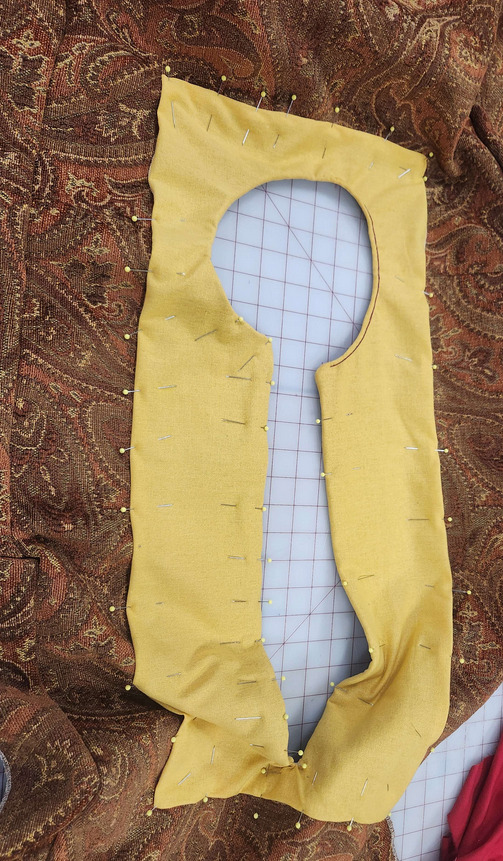
For the sleeve cuffs, I pinned them in place, ran a quick line of running backstitch along the tops of the cuffs to secure them in place, then did split stitch at the top of the cuffs and a running stitch around the opening to keep the edge tidy while still not using visible machine stitching.
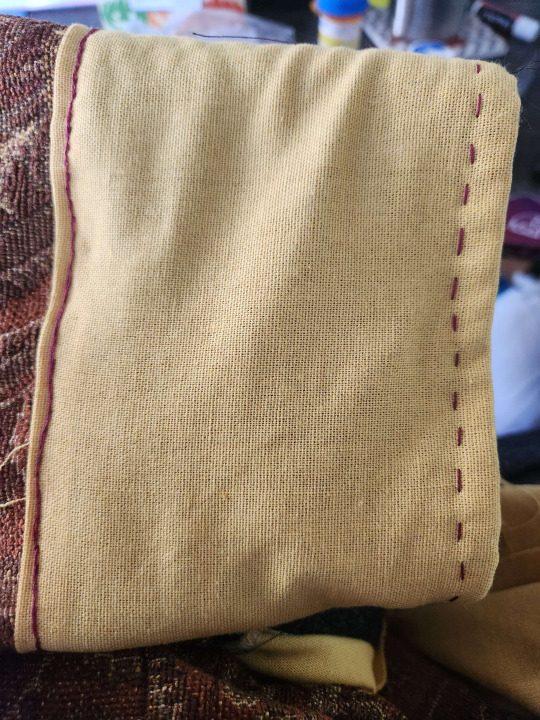
One thing the recipient of this garment expressed is that the striped facing secured with buttons or toggles is an ideal look, and luckily I have a significant quantity of the Vindheim buttons from Bad Baroness in stash. I do not have sufficient woven or braided trim in truly appropriate quantity or style for this garment to be aggressively period, but with the fabric we're already taking liberties and the ribbons look nice and appear to be a popular substitute for strips of silk tape performing the same function in our area. I laid the ribbon out at inch and a half intervals and made sure my lines would be straight on both sides. I turned the ends of the ribbons in and secured them with a whip stitch in a matching thread.
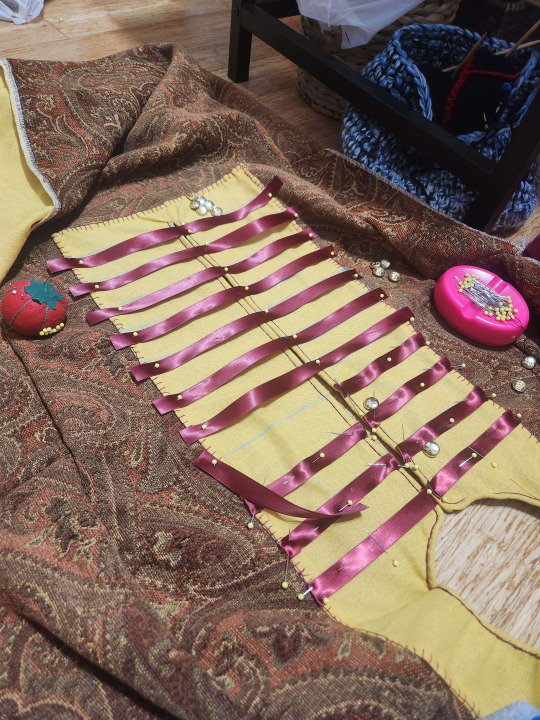
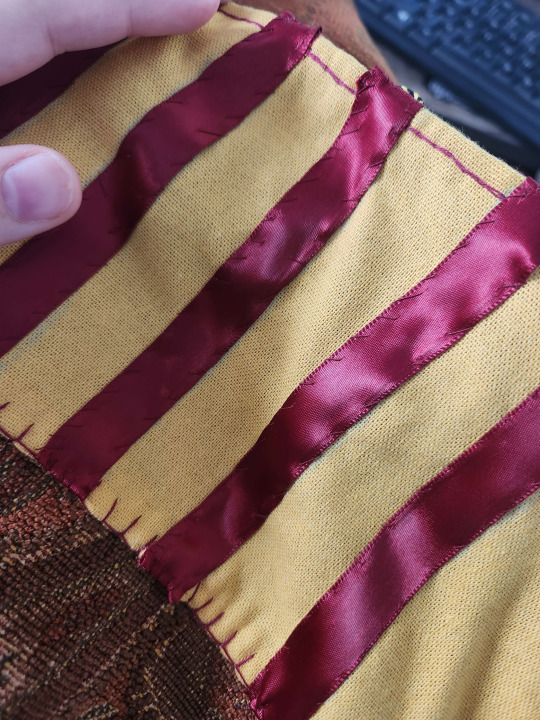
With my facing done and the worst of the neckhole dealt with, I seamed the rest of the garment into an actually clothing-shaped piece of fabric and let it hang for a day while working on other projects.
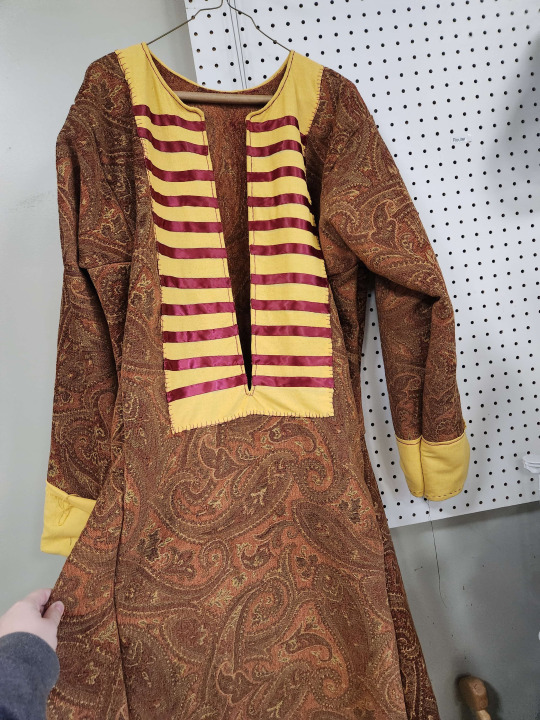
I decided to use a "looped cord" method of button loops, using a cord from an old site token that happens to look an awful lot like the cord used for an award the recipient has received. Starting from the bottom of the neckhole, on the wearer's right side, I've tacked the cord down under the edge of the garment, securing the loops aggressively.
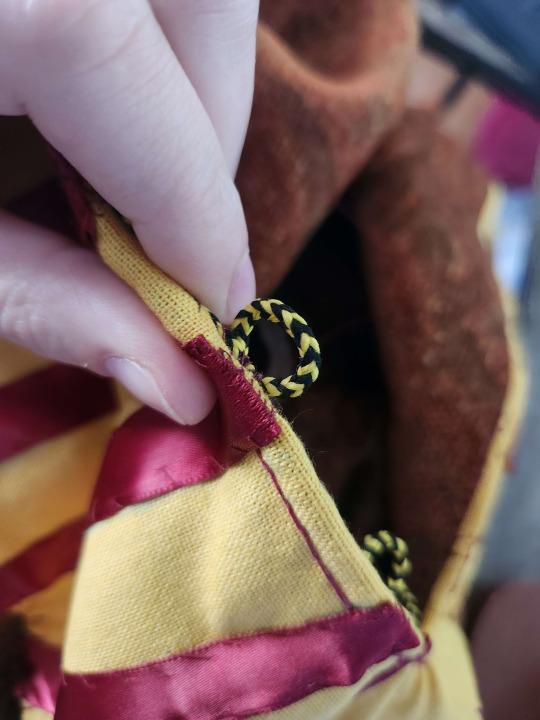
Sometime soon I will get clearer pictures of this garment on the recipient.

The more I look at this garment and all other Rus-ish garments i've made and seen, I think I may need to round the gores into the "skirt" of the tunic more dramatically. I can no longer find the artistic depiction that originally gave me the impression, but until this point i've been letting the right angles of the skirt remain as initially cut, giving an angular overall silhouette but the rounding may be necessary for the right look.
#arts & sciences#a&s#sca#society for creative anachronism#historical costuming#rus costuming#garb#rus and norse#tunics
8 notes
·
View notes
Text
𝓧𝓮𝓷𝓲𝓪 𝓽𝓱𝓮 𝓥𝓲𝓴𝓲𝓷𝓰 𝓟𝓻𝓲𝓷𝓬𝓮𝓼𝓼 𝓸𝓯 𝓡𝓾𝓼 & 𝓷𝓮𝔀 𝓠𝓾𝓮𝓮𝓷 𝓸𝓯 𝓚𝓪𝓽𝓽𝓮𝓰𝓪𝓽
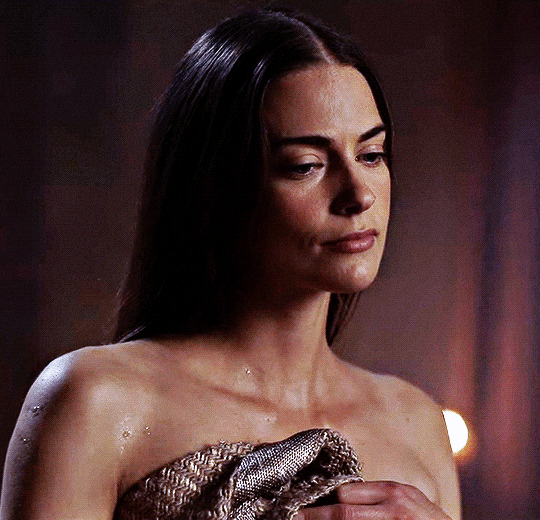

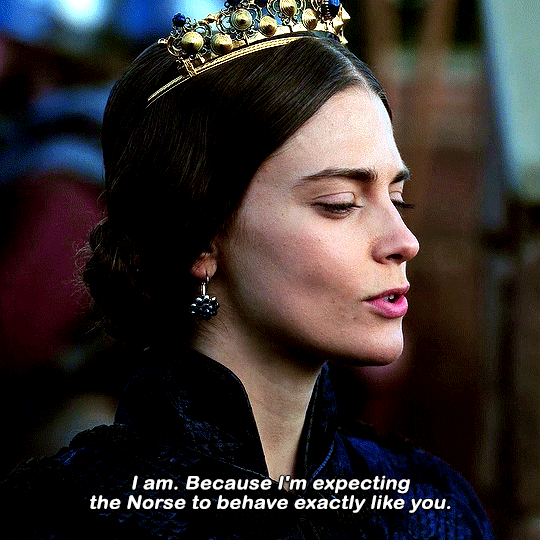
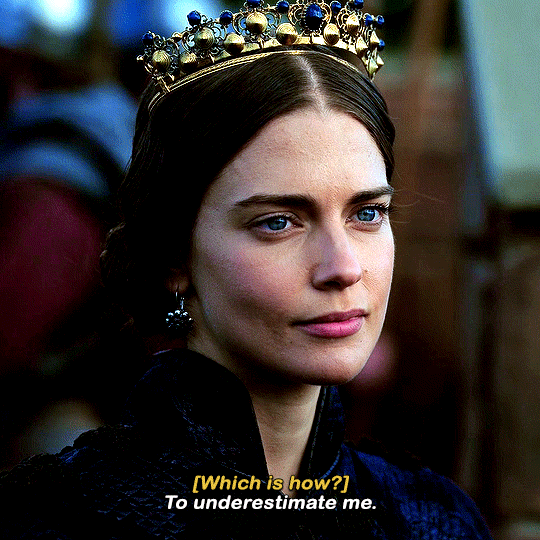

Xenia Lothbrok formerly Rurikovich better known as Xenia of Novgorod and called among her people the Viking Princess is the princess of Kievan Rus, daughter of the late King Rurik, Igor's older sister and niece of Prince Oleg, Dir and Askold. Always protected and guarded, Xenia grew up lovingly among her family, raised in the belief in the Norse gods and raised as a proud Viking woman, to which her people belonged before converting to Christians, still firmly maintaining her faith today, like her father once, who was a convinced Viking, warrior and king and still today refuses to follow the Christian faith, which she sees as a threat. As the only child of her parents, Xenia had a strong will from an early age, knowing how to use it to make others follow her will and to captivate them with her charm. In addition, she showed early on what she wanted to fight for by taking a great interest in the battles, travels and plans of her father, who included her in their plans from an early age and relied on Xenia's intelligence and acumen, which made men passionate and skillful supported, which is why he took them and their uncles with him into battles, on the sea and on raids. After the birth of her brother and the death of her mother, she took over her mother's upbringing, grieving but outwardly appearing strong and determined. Shortly before her father's death, he appointed Oleg, his brother-in-law and closest confidant, as regent and leader of the Rus and entrusted him with the care of his children. Due to the dispute between Oleg and his brothers, both siblings were separated, which is why Xenia initially grew up alone under Oleg's supervision and was considered Oleg's little darling in Kiev for a long time, who was a substitute father for the princess, taught her a lot and was the only person that Oleg really loved. Since Oleg's hunger for power and his madness encourage him to own the country for himself, Xenia once again loses part of her family and is on her own. This is now considered to be treated with caution, not to be underestimated, as combative, respected by the people as a strong, direct and honest young woman who is beginning to make her own alliances among the Rus and knows how the game is played and is the only one who always defies Oleg, who now sees her as a danger. While time and losses have shaped her and coldness and harshness characterize the princess, who seems aloof and doesn't let anyone get close to her, which often makes her appear arrogant. However, behind this mask in order not to appear vulnerable is her mother's gentle nature, great sensitivity, a feeling for others and wanting to help them, her good-natured heart that burns for those she loves and is loyal to them and Igor is similar is than everyone else assumes. When Igor also falls into Oleg's hands and Xenia gets to know Ivar the Boneless, she reveals herself to him, who becomes her only confidant and she also builds a close bond and supports him in his plans to overthrow Oleg and take Igor away from Kiev. After this success, the rest of the small family is united and the Rus are stronger than before. Despite the admiration of her people and her role as an advisor to Dir and Igor, she always feels alone, doesn't belong and is sure that her fate lies somewhere else. Far away from their home, the two men and the Christians. Now she lives in Kattegat with her beloved husband King Ivar, at his side and as the new Queen of Kattegat and mother of Cailan Ivain, Vidar Ragnar and Edda Aslaug. ⸻ Vikings.
41 notes
·
View notes
Text
Hello world! :)
My name is Ru, I am 24 years old (1999) and use they/them pronouns. I am autistic and experience chronic pain.
I am an eclectic witch and love to explore magic with everything possible! I think magic is just so brilliant I couldn't nail down a category for myself if I tried 😂 My favourite thing to do is write original spells and share them with everyone I can, as well as create tarot spreads in the moment when doing a reading with my deck. I hope to share both of these things with all of you here 🥰
I am a Lokean and have been since 2018! If you ever followed a blog called "Loki'sCinnamon", that was me. Sadly, when trying to delete a side blog I no longer used, I accidentally deleted my main blog. In an instant I lost the last two+ years of my record with Loki, all of my original craft work, and connections with all the mutuals I had formed. I was devastated, and didn't feel ready to come back to tumblr again for a long time.
I think I am ready to start again now.
Sometimes the chaos of a forest fire makes way for the growth of new trees, after all 🌿
Currently I am just working with Loki as to not overwhelm myself, but I have also worked with: Odin, Hel, Thor, Hades and Persephone!
I would truly love to use this blog to get back into the world I once had here and make connections with people who also practice witchcraft and know Loki is so much more than the negative stereotypes that closed minded people shrink them to.
Please feel free to send me a message if you pick up on some good vibes (I met someone who I consider family to me back in 2018 right here through a Loki connection! 🥰), as making friends as a ND adult can be very hard, I will do my best to reply!
Or: please submit an ask if you would like a free tarot reading or a free original spell creation based on your request :)
I want to put my skills to good use and make connections, feel free to request from your blog or anonymously and sign off with an emoji, I don't mind which works best for you at all 🥳🖤🩷💚💙
#ru rambles#ru readings#lokideity#tarot#paganblr#paganism#paganlife#pagans of tumblr#pendulum divination#pendulum readings#eclectic witch#norse pagan witch#norse witch#pagan witch#tarot witch#witch community#witchblr#witchcraft#loki deity#lokean#loki devotee#loki devotion#norse loki#free tarot#tarot cards#tarot reading#tarotblr#tarotcommunity
8 notes
·
View notes
Text

The Varangian Guard
988-1453
#varangian guard#varangians#varangian#constantinople#men at arms#the varangian guard#osprey#byzantine#army#scandinavian#byzantine army#norsemen#anglo saxons#rus#byzantium#norse#kievan rus#nordic#history#europe#european#byzantine empire#germanic#vikings#raffaele d’amato#giuseppe rava
126 notes
·
View notes
Text
I love that with a couple asterisks, you can say "Vikings VS. Romans with flamethrowers" is a historical matchup that actually happened
#the asterisks are as follows#its the byzantines so still the roman empire (fight me) but a thousand years of cultural development removed from the romans you imagined#Its the Rus so like... slavic-norse culture from the area thats now Ukraine and russia and that general area#and flamethrowers are greek fire. I'm sure we all know everyone's favorite brand of medieval napalm#anyway ain't history neat?#history#romans#roman empire#byzantine empire#byzantium#vikings#greek fire
2 notes
·
View notes
Text
Question
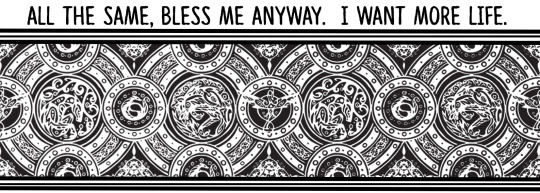
is this a decent lower arm tattoo? I'm gonna trace it out at some point to simplify out the design and adjust the font (I made the patternwork for a bigger and higher detail print area so I think I need to go over it with a relatively thick pen and scrap some of the fine detail, especially on the large wolf which even at this level of detail is a bit fussy)
Aiming for it to be a band covering around half my lower arm, so about 10-12cm across
#red said#I'm also worried about whether it's an appropriate thing to get tattooed#bc it is an original My Design buuuut it's based on a lot of very specific visual languages from cultures I'm not part of#several of which have very specific spiritual and religious significance attached to the design languages#i think I'm overthinking it bc it isn't meant to be In The Style Of any specific cultures even though it's drawing partial inspiration#but idk it's important to be on the level about that stuff if you commit to getting it inked on your own skin#for reference the cultures are rus COMMA norse COMMA and tlingit#with a tiny bit woven in from nepalese design work#bc the design is meant to evoke Fantasy Country In SubArctic Frigid Temperate Zones#so for all the design work in the RotE project i tried to draw on cultures from multiple continents in similar landscapes#to make fictional design vernaculars that suited the flavour of the fantasy cultures without defaulting to Medieval Europe#but idk i think that design fusion means different things in that context#vs as out of context pattern work
23 notes
·
View notes
Text
You know what I'd like? I'd like a Chinese fantasy show - standard historical fantasy sort of thing - about a group of martial artists/cultivators being sent on a journey to the utter West. Following some sort of prophecy or something.
Of they go, fast forward, they get as far as Constantinople at the height of its power (history? accuracy? bah!), and our intrepid group of cultivators run afoul of a group of Varangians (surprise co-production with Scandinavia y/y?). Not as in sworn enemies, just - they keep accidentally crossing paths in unfortunate ways, keep having cultural misunderstandings, and occasionally end up hanging out just because.
Both groups are hanging out at the same inn - and either somebody's singing a mournful song of home, prompting questions of "where did you hear our prophecy?", or somebody's reciting the prophecy, prompting "when did you ever visit Iceland?"
So, yeah, long story short the Varangians - who were about to head home anyway - agree to act as escorts/guides to our intrepid cultivators, who for mystical reasons need to get to Hekla.
Off the show goes, along the rivers through Rus to Scandinavia and then further North, beneath the Northern Lights to Iceland.
Of course, this is a artistic license fantasy show - so our Varangian/Norse friends? Turn out to have their own magic powers. Saga style magic powers. Maybe somebody gets replaced by a bear whenever he falls asleep. Maybe somebody's mother was a troll. That sort. And the Northern Europe of this show is definitely fantastic - there's probably a sea serpent somewhere.
They get to Iceland, they do whatever needs doing - turns out, our intrepid cultivators now need to rush home to finish the magic whatever back in China.
And, of course, now they and the Norse have bonded, especially one of the cultivators and one of the Norse (handsome fellows, naturally), and so of course their escort have to go escort them right back (besides, if there's really a city more glorious than Miklagard, they need to go see for themselves).
So, back to fantasy China we go...
658 notes
·
View notes
Note
what are your asoiaf culture/race headcanons?
ooo im siberian starks truther forever, or just general indigenous arctic circle north. general aesthetics of slav/kievan rus. like kokoshnik ushanka and ryasna are canon to me. harsh, stilted syllables like in russian.
the riverlands is the balkans + ireland to me for sure, cat is so irish to me. i think of like south slav folk costume for them :) lots of ribbons and embroidery and intricate braiding. lilting accent
i like east asian targs :) but also like, they just arent any earthen race to me. hate when people are like "erm they cant be coloured cos they have purple eyes and silver hair?" and its like do white people have purple eyes and silver hair??????
the dornish are a mix of indian subcontinent+west asia+sephardic/mizrahi jewish+palestine+turkish+arab. the melting pot of westeros! like the daynes are jewish to me, and the rhoynar are arab/turk/'moorish'. yronwoods are white latines. sea of dorne/narrow sea evokes the mediterannean :) dornish is described as melodic and drawling, def lots of rolled Rs
stormlands is very german+eastern europe. maybe im jsut thinking of oktoberfest but i always think of them bundled up. lots of headdresses. harsh accent.
vale of arryn is very anglo to me. french/english/swiss/etc. yodelling on the mountains. sweet and sing-song accent.
westerlands is italy to me cos i like thinking of the borgias and lannisters. lannisport gives off SUCH florence/venice vibes.
the reach is again quite meditteranean to me. maybe its the wine? but i hc the tyrells as black, i think the dynamic of "upjumped stewards" compared to the "blue-blooded" hightowers, florents, etc is interesting. its why i also hc the manderlys as black, since they're from the reach :)
iron islands... obviously norse/viking, but i like pasifika headcanons too. i like asha with moko kauae and i just love if the ironborn have cultural tattooing practices. this is lessened by how they do not at all have a pacific climate lol.
51 notes
·
View notes
Note
I am watching a video with criticism of geographical determinism in worldbuilding and realized that I don't really remember seeing any fictional stereotypic merchant state that relies on rivers.
Norse and Rus were whom I had in mind, but to my knowledge British and Japanese people also heavily utilized rivers for trade and I would be very surprised if Ancient Chinese people didn't.
I don't know about history of First Nations of North America and did they have trade in our understanding, but I heard that river system of North America is so convenient that the entire 19th century demand for transportation could have been covered by it alone, without trains.
Just some ideas
Freshwater systems are woefully underused in worldbuilding. The other day I was reading about the history of my region and I was amazed at how big and sophisticated native canoes were in the Paraná, the Paraguay and the Amazonas, and how virtually nobody talks about it. We are talking about ships that could hold about 30 people and some were bigger than Columbus caravels. For centuries into the colonial era, the Spanish and Portuguese hired or pressed into service native navigators for the rivers which were though to navigate as a sea. Still before that, they were the major arteries of commerce and trade through the continent, this is well known. Even Patagonian goods are reported in Corrientes (North of Argentina) which indicates that trade there got very far. As for the Chinese, not only rivers were important to the but also they boasted an amazing canal system but that's about all I know.
One thing I learned recently about rivers and cities is that cities were often founded on the side of rivers, yes, but almost never at their mouth. Look for example at Paris, Rome, London, the Egyptian capitals. They were founded by the river, but the mouth of the river next to the sea is where the delta is, and deltas always change and flood, carrying mud and slit, they aren't good places to build at all. Good river cities are built in the 'deep side' of the river where you can build ports, not in the side where sediment accumulates. Another issue with river cities are marshlands. For example, I remember reading that the marshlands of ancient Rome were drained at great cost. Ancient peoples knew that marshes were 'unsanitary' even if they didn't know why (it's because they host mosquitos and parasites, not because of anything bad wetlands have on itself) and they had to deal with them. There are some exceptions to this, like Venice which was basically built on a marshland (or the Netherlands).
And indeed rivers were (and still are! I see ships going up and down the Paraná every weekend!) a very efficient way of transportation. There's lots about it written in Europe, but river barges were basically the railroads of their time. Before the advent of railroads, people in Europe (and China) weren't thinking roads, but canals, the French built a lot of canals at great expense which became obsolete later by railroad.
Unfortunately the sources about river canoes and transportation in America (continent) are often tucked away in papers and history books, there really isn't that much accessible literature and illustrations about it. Which is a goddamn shame because learning about native canoes bigger than Spanish caravels (and they were still building them in Paraguay and Argentina during colonial times, according to my sources) blew my mind.
22 notes
·
View notes
Text
Unexpected: Part 3
Summary: Thickheaded idiot Ivar finally realizes he’s in love while going to the market with her to get her new clothes and wise NPC (tm) gives him some advice. Aslaug takes her in for an interrogation à la overbearing mother… More smut ofc, but it’s a bit brief this time!
Beginning Notes: the Brísingamen is a necklace that was given to Freya in Norse mythology. From the etymology of the word, it’s possible that the necklace was meant to be made of amber.
Taglist: @bragisrunes @deans-ch-ch-cherrypie @punkrocknpearls @alicedopey @batmandallyboy (hmu to be added!)
Masterlist | Part 1 / Part 2 / Part 4 | requests are OPEN!

He woke up next to her this morning. Ivar can barely process it. When she moved in her sleep, he’d woken up, and he’d gotten to hold her while she was still sleeping, running a hand through her hair carefully.
She’d smiled at him when she had woken up, kissed him, gotten dressed halfway, and then Ivar had ruined her efforts and they were late to breakfast.
Now that she was his, she didn’t have to serve anyone else. Unlike Margrethe, she doesn’t dare sit down at the table, instead pouring his drink and refilling his mother’s and brother’s cups as well. Ivar glares at Sigurd, who leans towards her just to tease him.
Ivar knows that he is more interested in men than women, and that he’s fucking one ever since Hvitserk and Ubbe are taking up all of Margrethe’s time, but he still clenches his fist in jealousy under the table.
After breakfast, they head out alone. Sigurd leaves first, grabbing his Oud before he disappears to Gods know where, and Hvitserk and Ubbe leave soon after, saying that they’ll spar a bit. Ivar doubts it. Then again, his intentions aren’t the purest either.
She follows him dutifully to the market, carrying an empty basket. Before they can buy anything, Ivar spots Helga, who hands him a small vial. She smiles at her brightly.
“This is for your legs. It’s a new recipe, so tell me if anything is off.” She says, looking at Ivar.
Ivar nods, and she’s quick to take it, putting it in her basket.
“Do you need anything?” Helga asks, turning to her. She shakes her head.
“Bodil’s fever is gone, thank the Gods. It would’ve broken Estrid’s heart if her last daughter died too. That Frankish slave, Lothar, he cut himself quite deep, but the others already shared some of your old supplies.” She replies.
“That’s good. If you need anything, don’t be shy to come to me.” Helga says, walking away. Then, Ivar turns to her.
“How do you know Helga?” he asks.
“She helps us a lot. Whenever she can spare her supplies, she gives them to us. There’s a thrall that used to be in Floki’s service who learned from her. She’s a very kind woman.”
“That is true.” Ivar nods. He didn’t know Helga helped the slaves, but it’s her character to do such a strange thing.
The first stall they stop at is a fabric stall. The merchant looks like he comes from Rus, and his heavy accent confirms Ivar’s expectations.
He offers Ivar a good deal on a ready-made dress and a fur, but when Ivar turns to her, her eyes are wide.
“That is too expensive.” She says decidedly. The merchant immediately tells her he’s unwilling to haggle, but she shrugs, choosing a plain fabric instead. Ivar is sure it’s meant for aprons, but the light blue color suits her, so he hands over his coin.
“You need a pelt for when it gets colder.” He tells her. She looks uncomfortable at the thought, but nods.
“But not from this stall. This is luxury clothing he’s selling.”
Ivar lets her lead him away from the stalls on the main road, and towards a tiny stall that sells pelts as well as a few vegetables that have definitely been grown in the sorry soil of Kattegat.
She seems to know the vendor, who looks surprised at seeing a prince at her stall. Ivar chooses the fur, and she immediately begins haggling with the woman, before they settle on a price, she deems reasonable. Before they leave, Ivar spots a deep green, but still plain dress.
“That one too.” He tells the woman.
“You really don’t have to.” She insists, but the vendor readily holds it out for Ivar to inspect.
“No discussion.” Ivar tells her. “You need more than one proper dress.”
“I can make at least three out of this fabric.” She replies but lets him buy the dress.
They walk back onto the main road together, and she offers to go home. She’s blushing as she looks at the green dress, and Ivar can tell that she can’t believe the amount of money he just spent on her.
“I want to keep looking.” Ivar tells her. The blacksmith lives next to the stalls, and Ivar wants to pick up an axe he commissioned. Then, he wants to go to the stall of a Francian who sells wares from the Mediterranean. His mother loves oranges, so Ivar always goes to see if they have any.
While he’s at the blacksmith, he gives her money to go to the Francian. He follows soon after, only to see that she’s still at the stall.
“I don’t sell to thralls.” The merchant tells her as Ivar comes closer.
“It’s not for me, and I have the money. My master sent me to buy them.” She explains. “And I can take the bad ones off your hands, if you’d like.”
“Stop begging and buy off of someone else.” The merchant hisses.
“Is there a problem?” Ivar asks, stepping next to her. His axe is still in his hand.
“Prince Ivar!” he exclaims. Turning to her, he asks, “Why didn’t you tell me who your master was?”
“I didn’t think it mattered.” She presses out, and Ivar can see the barely concealed anger in the way she clenches her jaw, and her knuckles turn white on the handle of her basket.
The merchant hands over the oranges, and then turns around and gives her another crate.
“The bad ones.” He says. Ivar looks at them and sees a few with marks, some with a little mold on them. He would never eat them, but she smiles brightly and thanks the merchant.
“Why did you ask him for the foul ones?” he asks her as soon as they are out of the rude merchant’s hearing.
“They’re not foul.” She laughs. “Just a bit old. These stalls are luxury stalls, so they usually don’t even sell to random thralls, but once, Bodil found a mandarin after the stall had closed down. She brought it to the thrall quarters and shared it with all of us. We kept the peel because it smelled so good. Since then, we’ve been trying to get more, whether that’s the old ones or something that fell off his cart.”
Ivar thinks he understands. There’s one last stop he wants to make today, but before they make it, she spots a young girl. Ivar follows her gaze. It’s another thrall, who waves to her. The girl can’t be older than seven. Unsure, she glances to him.
“Go.” Ivar tells her, and she almost runs off, taking the young girl into her arms. He sees them chatter and the girl grabs an orange from the crate, holding it up high over her head triumphantly. She reminds Ivar of Hvitserk. Ivar turns to the stall he wants to visit.
“I want to buy a necklace.” He tells the merchant. They know each other well. She’s an old woman, who was already selling her jewelry when Aslaug came to Kattegat. Ivar has been going to her whenever he wants to buy his mother a present.
“For your mother?” she asks, and Ivar shakes his head.
“For the girl?” she guesses, and Ivar stares at the ground.
“Just a simple one. With a stone or so.” He tells her. She turns around, going through one of her displays, until she finds what she’s looking for.
It’s a simple band with an amber pendant she hands him, and Ivar finds it almost painfully on the nose.
“Would you like a ring to go with it?” she asks in an almost teasing voice, and it’s only because Ivar has known her all her life that there are no consequences.
“What would I need that for?” he asks coolly.
“I’ve never seen you with that girl before, but I can tell when men are in love. It’s why I sell so much.”
“Secrets of the trade?” Ivar asks sarcastically.
“Precisely that. Tell her you’re in love. And free her if you haven’t already. I’ve heard nothing bad about that girl, and it’s obvious to me she loves you back.”
Ivar nodded, handing over the money before quickly leaving the stall, necklace clutched in his hand. She enjoyed gossip, entertaining his mother whenever she came to her stall, Ivar knew that. She also enjoyed making money. Was it really true that she liked him?
She’s spinning the girl around as Ivar comes closer, before she hugs her and turns around to find him. She almost bumps into Ivar.
“Oh sorry.” She apologizes. “I’m a bit dizzy. You know, from all the turning.”
Her hairdo is dangerously close to falling apart, and Ivar wants to fix it for her later.
“Who was that?” Ivar asks.
“That’s Bodil. I gave her the oranges so she can share with her family and friends.”
“What about you?”
“I already got fabric and a dress, AND a fur coat. I don’t need more luxuries.” She shrugs.
Shakily, Ivar grabbed the amber pendant. “I still want to give you this.”
She accepts it carefully, as if it’ll crack if she cradles it too harshly. “Thank you, Ivar. It’s absolutely beautiful.”
Then, she hugs him, in the middle of the main road. Ivar freezes, not knowing what to do. Carefully, he lays his head on her shoulder.
They walk into the Great Hall the moment Ubbe and Hvitserk return, and Ivar shoots her a regretful glance as his brothers pull him away.
“I’ll clean your room and change your bedding.” She calls after him, disappearing with her new things.
Aslaug’s POV:
Ivar and his thrall had come back from the market just in time for Aslaug to watch her disappear into his room. She didn’t trust this woman. Perhaps she would use Ivar’s trust to steal something he wouldn’t miss. Perhaps she was as ambitious as Margrethe.
Aslaug was going to find out.
The thrall didn’t notice her at first. She was pulling the linens off of Ivar’s bed, her back turned to the door. Only when she turned around did she see Aslaug.
“My Queen.” She said, bowing her head. “Prince Ivar bought you oranges. I’ve had them brought to the kitchens. Is there anything specific you’d like them with?”
“What are your intentions with my son?”
“I don’t have any intentions.” She replied.
“Why did you sleep with him?” Aslaug continued.
“I thought he was attractive.”
“Despite his legs?”
“I’m not as superficial as some other women.” She said calmly.
“Would you like to be free one day?” Aslaug asked
“Which thrall doesn’t?”
“Do you love him?” Aslaug asked finally. There’s silence from this quick-witted thrall. It lasts too long to be a lie. She doesn’t answer Aslaug at all. The queen grabbed the thrall’s jaw, making her look up at her. Aslaug noticed how young she looked. She couldn’t be much older than Ivar.
She remembered her vision. Aslaug had dreamt that Ivar would marry a thrall one day. She had also dreamt that Ivar would die at sea before he would marry. Her visions did not help her. They only conflicted each other.
“He cannot free you.” Aslaug told her.
“Being his thrall has already made me happier.” She replied.
“He’ll marry someone else. A worthy princess or an earl’s daughter. Not you.”
For a moment, Aslaug sees her façade drop. A second of hurt and jealousy. Then it was over, and Aslaug let go of her jaw.
“Break his heart.” She told the girl, “And you’ll have his family lining up to kill you before he does.”
“I know.” She replied, as if that didn’t scare her. Then, the thrall continued cleaning the bed, as if their conversation had never happened.
Ivar’s POV:
She was talking to Hvitserk. Why the fuck was she talking to Hvitserk?
He creeps closer, trying to make out what she’s saying. Hvitserk’s laughing at something she just told him, and it makes Ivar’s blood boil.
“I can teach them how to make the bread.” Ivar can finally hear her say. What?
Hvitserk sees him, and smiles at Ivar brightly. Absentmindedly, he hands her his cup, and Ivar wants to start a fight with him for disrespecting his woman. Except that she is a thrall, and all she’ll ever be is his property.
“I was just asking her about the bread she made. Now that she isn’t in the kitchen, it’ll be the old bread again.” Hvitserk explains.
“Stay away from her.” Ivar tells him, before going to her.
“Jealous?” Hvitserk teases.
“Shut up.” Ivar almost roars over his shoulder.
“If it’s alright I’ll teach the others in the kitchen how to make the bread sometime next week.” She offers.
“I don’t want you talking to Hvitserk.” Ivar says.
“He’s your brother. I’m bound to see him when I’m living in your home.”
Ivar’s hand shoots up, resting on her neck.
“He’s good with most women. I’m not.” Ivar presses out.
“And I am not most women.” She replies quietly. “I thought we’d already established that.”
Ivar could feel the anger creeping up on him. Suddenly, every man in the room was staring at her. The two shieldmaidens making out in the corner seemed to be waving her over, asking them to join. Sigurd was there, Hvitserk was there, Ubbe was there, even Bjorn was there.
They all look like they were going to take her from him. And the worst part was, Ivar knows they could.
“Go to my room. Now. Take that dress off.” He tells her, before letting go of her neck.
He stays until he can’t bear it anymore before he walks towards their room. Hvitserk throws him a look that used to be reserved for teasing Ubbe, but no one else in the Great Hall notices.
When he gets to their, no, his room, the dress is barely over her shoulders.
“That was fast.” She comments. Wordlessly, Ivar grabs her, pushing her against the door. Her back hits it with a quiet thud, and she lets him tear the dress down her shoulders. The necklace rests between her breasts, a reminder that she’s his.
His fingers are on her, groping greedily because Ivar wants to somehow show her that he loves her, and that he wants her to be his – in a way that she cannot be.
“You’re mine.” Ivar says harshly, “Only mine.”
She nods frantically, and Ivar knows that, in any other situation, she would’ve said something snarky.
“Say it.” He demands. He can feel the desperation inside him growing, he wants her to tell him she feels the same way. He needs her too.
“Yours.” She breathes out, the word ending in a moan when his hand finds her pussy.
She repeats it from her own volition, over and over as Ivar leads her to his bed and sucks dark splotches onto her skin. Her hands trail down his chest, towards his breeches and Ivar lets her do it, because this is something he can trust her with.
Her hand finds his cock and she pumps up and down, until Ivar is groaning into her neck, almost ready to beg her. When he pushes into her, it feels just as good as the first time, but this time, Ivar isn’t tense, only angry.
He wants to be gentle with her, so he kisses her slowly, lets his touch become softer. He still squeezes her neck and grabs her hips, because that’s as gentle as Ivar will ever get. When he’s done, he pulls out, using his fingers to get her to finish too.
They lie side by side in silence, and Ivar can hear the sounds of the feast taking place behind his door. He wonders if they heard them. A part of him wants them to know that he can do it. Another part wants her to be his secret.
Her hand finds his. She holds it as carefully as her necklace of amber, staring up at the ceiling. Ivar looks at her, but she doesn’t notice, and for the first time, he sees her. He sees a reflection of his anger in her. It’s hidden much better, but it’s there.
“Why are you angry?” he asks her. She hesitates, as if she’s considering lying to him.
“The merchant.” She replies.
“I can have him killed if you want.” Ivar offers. She shakes her head, beginning to smile.
“And what would that do?”
“He wouldn’t be able to disrespect you without a head.”
“It wouldn’t change anything. There’ll always be people treating me like I am worth less than cattle. It’s stupid to be angry at them, but I can’t help it. Even if someone freed me, I’d always be the former thrall.” She explains. Ivar knows that he cannot understand fully what she means, and that makes him angrier than before.
“They wouldn’t disrespect you if you were a queen.” Ivar blurts out. She turns to face him, a hand running through his hair.
“My Ivar.” She says, and his heart skips a beat. “We both know that won’t happen. You love your mother far too much.”
I love you too. Ivar wants to say, because he can hear it between the words she does say, I love you and I’d break my promise to my mother for you. I think.
“You’re the only one in the world who understands my anger.” He says instead. It has to be enough, for now.
#ivar#ivar x reader#vikings#ivar the boneless#history vikings#ivar lothbrok#ivar x you#ivar x oc#ivar x y/n#angry ivar#ivar fanfic#ivar imagine#ivar smut#vikings fanfiction#ivar ragnarsson#hvitserk#ubbe#sigurd#aslaug
671 notes
·
View notes
Text
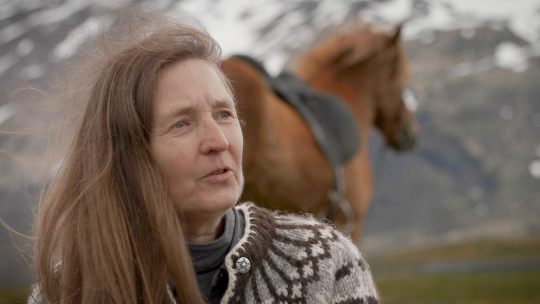
Viking historian Nancy Marie Brown’s new book, The Real Valkyrie: The Hidden History of Viking Warrior Women, explores what life might have been like for the warrior woman of Bj 581. Using more evidence from the recent tests conducted on the remains, Brown traces her journey from Norway to the British Isles to Kiev then, finally, to Birka. Brown imagines the unnamed warrior meeting other prominent Viking women, such as Gunnhild, Mother of Kings, or Queen Olga, ruler of the Rus Vikings in Kiev. She also explores the Viking sagas and contemporary sources with a new lens.
Atlas Obscura spoke with Brown about her new book, valkyries, and the assumptions that underlie the history we think we know.
How did you initially get interested in Vikings—and female Vikings in particular?
When I went to college, I actually wanted to study fantasy writing and, you know, learn to write like Tolkien. I learned very quickly that that was not appropriate for an English major in the 1970s, so I decided to study what Tolkien studied, and he was a professor at Oxford University, teaching Old English and Old Norse. So I started reading all of the Icelandic sagas that I could find in translation. And when I ran out of the English versions, I learned Old Norse so that I could read the rest of them.
One of the things I liked about [the sagas] the most was that they had really interesting women characters. There’s a queen in Norway who appears in about 11 sagas, Queen Gunnhild, Mother of Kings. She led armies. She devised war strategy. And then I was looking at the valkyries and the shieldmaids and thinking, you know, these are really interesting people that have always been considered to be mythological.
So when I learned in 2017 that one of the most famous Viking warrior burials turned out to be the burial of a woman, that just absolutely dazzled my imagination.
Is this the first confirmed grave of a female warrior that we have?
This is the one that has the best proof. There are one or two others that have since been DNA tested and proven to be female. But in each of these cases, it’s hard to say if the person in the grave, whether male or female, actually was a warrior, or if the object that we are interpreting as a weapon was used for hunting or for some other purpose.
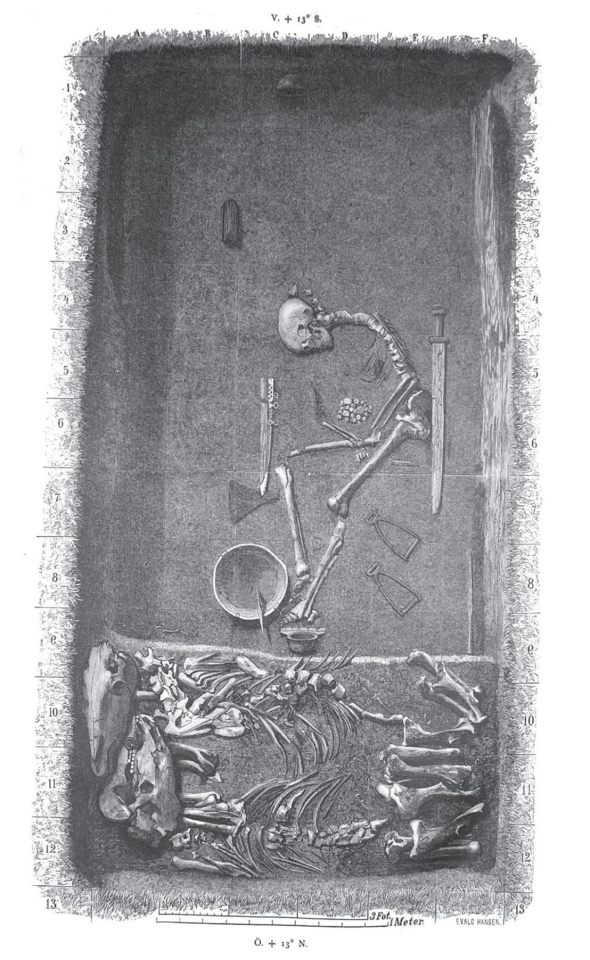
What do we know about the life of the Viking warrior woman in Bj 581?
In 2017, by testing her bones and her teeth, [scholars] could say she was between 30 and 40 years old when she died. They could also tell that she ate well all of her life. So she came from a rich family or maybe even a royal one. She was also quite tall, about 5’7”. By the minerals in her inner teeth, [scholars can determine] she may have come from southern Sweden or Norway, and also that she went west maybe as far as the British Isles before her molars finished forming. She didn’t arrive in Birka until she was 16.
We also have her weapons and a little bit of clothing that were found in the grave. And these link her to what is known as the Vikings’ East Way, which was the trade route from Sweden to the Silk Road.
We can link, through the artifacts and through the bones, that she could have traveled from as far west as Dublin to as far east as at least Kiev in the 30 to 40 years of her life.
How do we know that there were Viking warrior women?
They are mentioned many, many, many times in the literature. In most cases, they have been dismissed as mythological because, of course, we know warriors were men. But we don’t know that. That is an assumption that is based on traditional Victorian ideas that because women are mothers, they’re nurturing, they’re peacemakers, and they don’t fight.
That’s not historically true. Women have always fought. And they appear in most cultures until the 1800s, when Viking studies and archaeology pretty much started. So we sort of have this problem of bias in our earliest textbooks.

There’s this assumption that the warrior men of myth must have been based on real people, but it’s not the same for the mythical warrior women. Why is that?
It’s just an assumption based on what people think women are like. Most of the material we have from the Middle Ages was written by men, and most of the material we have until the 1950s was written by men, and women are slowly making their way into the field of Viking scholarship. But many of them are still working under the assumptions that they were taught.
I noticed when I went back and reread some of the sagas in Icelandic that there wasn’t this clear distinction between the warrior women being mythological and the warrior men being human. When you actually look at the old Norse text, there’s a lot of words that have been translated as “men” that actually mean “people,” but it’s always been translated as “men” because it’s a warrior situation.

Is it possible for historians to remove all of those biases?
No, I don’t think it is. I think we all are looking through our own lenses. But we have to revisit those sources every generation to see past biases. So when you have layer after layer after layer of removing biases, you may get closer to the truth.
What most surprised you in the course of researching your book?
One of the controversies right now in Viking studies is should we really be talking about men and women at all? Maybe there were all kinds of different genders. We don’t know if there were more than two genders in the Viking age. Maybe it was a spectrum.
If you look at this one group of sagas called the Sagas of Ancient Times that are often overlooked because they have all these fabulous creatures in them, like dragons and warrior women. It’s really interesting [because] these girls grow up wanting to be warriors. They’re constantly disobeying and trying to run off and join Viking bands. But when they do run off and join the Viking band, or, in another case, become the king of a town, they insist on being called by a male name and use male pronouns.
So it was very shocking to me to go back and read it in the original and say, “Wow, all this richness was lost in the translation.”
#Nancy Marie Brown#vikings#history#women in history#archaeology#women warriors#warfare#warrior women#norse history#atlas obscura
362 notes
·
View notes
Text
Had a fun time drawing parallels between the Víga glúms saga and the Ibn Fadlan records and their respective descriptions of prayer among the germanic tribes. I felt compelled to clear up the misinformation spread by hyper-masculine pagan sources according to which heathens do not/should not prostrate themselves or kneel during prayer. Or at the very least, that the norse pagan doesn’t ask their deities for help, yada yada you’ve seen the quote that goes “we are norse pagan rawr we do not bend our knees to our Gods blah blah”, as posted by some oftentimes far-right oriented heathen sources with images of burly men wielding axes (ah yes, the typical norse pagan). The idea of prostration didn’t appear in the Víga glúms saga, but in both cases, a request is made and in humble fashion. Needless to say the idea that the germanic peoples, or at the very least, the Rus tribes and the Icelanders who practiced pre-christian religion would in fact request blessings of their deities. In any case, the idea that prostration/humility was absent in pre-christian religions is nonsense. One of the perks of being neo-pagan is that we get to choose the way we work with deities, whether that be by praying in a kneeling position, by praying in any other position, or by not praying at all. One shouldn’t feel guilt over the way they choose to pray, and if they even choose to do so. I’ll say once more that your path is yours to pick, and there are no rules to norse paganism. Just because this or that source states this or that is the right way to do things, doesn’t mean they are right. Even just by observing these two texts, it's clear that practice varied massively with time and within different nordic cults, which gives us great leeway when it comes to choosing how it is we want to pray, or if we even want to pray at all.

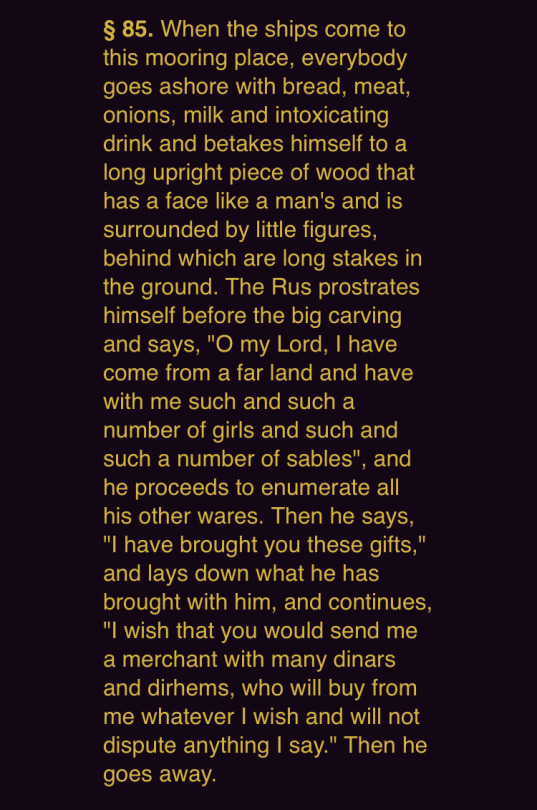
#thoughts#norse paganism#paganism#norse gods#deities#spirituality#deity work#polytheism#heathenry#pagan#personal kind of
44 notes
·
View notes
Text

Today I wore this beautiful pin in honor of Loki 🕷💜
#loki deity#lokideity#paganism#paganblr#paganlife#norse pagan witch#norse witch#norse deities#lokean#loki devotee#norse loki#deity offerings#ru rambles
4 notes
·
View notes
Text
Crossposting from Twxttxr: some interesting news about ongoing research by colleagues, from a workshop "Diversification of Uralic" just this Thursday and Friday
Do the Permic languages have loanwords from Old Norse? e.g. ONo. ár ~ Komi & Udmurt ar 'year'. This would've been sensible during the brief time when Norsemen originally from Sweden were in charge of trade along the Volga and settling in inner Russia, forming the Rus' (later Slavicized, but as we know from Byzantine sources they remained Norse for centuries) — and also the Norwegians too were known to conduct exploration + trade along the Barents Sea at the time, our oldest written reports of "Bjarmia" come from them after all.
Do the Finnic languages have loanwords already from Pre-Proto-Germanic into Pre-Proto-Finnic? My first reply would've been "yes surely", this has been discussed for half a century and there's dozens of etymologies out by now. Turns out though that there's still a lot of room for skepticism if we try to assemble a big picture. Most of these could be (and have been proposed by other analyses) to be proper Germanic after all, or from some non-Germanic kind of Indo-European, or even incorrect. There is unambiguous evidence I think at least of loans lacking *ā > *ō, but that's already though to be one of the latest common Germanic innovations, perhaps barely post-PG.
[Follow-up question: do we even know where Pre-Proto-Germanic was spoken? might not have been anywhere convenient for contacts with Pre-Proto-Finnic.]
— A few similar problems also in the less discussed supposed layer of Proto-Balto-Slavic or pre-BSl. loans, but by areal considerations it seems obvious to me there must've been Uralic/IE contact somewhere in the Russian forest belt for ages already, even if it might not have left enough evidence to clearly distinguish from things like pre-Indo-Iranian loans.
Do the Samic languages have loanwords that are not from any historically attested branch of Scandinavian, but some sort of a lost variety entirely? This could be an explanation for an unexpected sound correspondence *j → *ć in many loans; it might also explain some loans that look surprizingly archaic, e.g. lacking any reflection of Siever's Law. One example showing both is indeed *Tāńćə 'Norse', from some sort of a *Danji- variant of Proto-Germanic *Daniz.
Several new hypotheses on the history of of sibilants in Ugric, adding to the growing tally of evidence that traditionally reconstructed *s > *θ and *ś > *s "in Proto-Ugric" are actually later developments. A paper supposed to be coming out soon!
No linguistic evidence so far, but a 1670 travelogue by de La Martinière appears to still report seemingly pre-Uralic populations along the Barents Sea coast — and even on Novaya Zemlya, traditionally thought to have been uninhabited (as reported by other early modern explorers) before some Tundra Nenets briefly settled there in mid 19th century. Apparently there's been no real archeological investigation, but also at least two stone labyrinths are known as signs that humans still must've at least visited there sometime in the past.
[By current knowledge, labyrinths from Sweden and Finland have mostly been built in late medieval and early modern times though, so they don't suggest especial antiquity either. Could the ones on NZ in fact have been left behind by some of these historical Northwest European expeditions?]
Various discussion also on the development of Samoyedic. Nothing particularly all-new (maybe on Nganasan, more on that in a PhD thesis to appear later this year though), but a few main results include 1. clear recognition that there is no "North Samoyedic" group (as has been suspected for several years now), 2. confirmation that there is regardless a narrower Nenets–Enets group, and 3. some development of a model where all three of Nenets, Enets and Nganasan may have moved to the tundra zone independently from further down south (as is certainly the case for Northern Selkup, the most recent northern expansion of Samoyedic speakers).
#historical linguistics#loanwords#language contact#archeology#ethnohistory#uralic#finnic#samic#permic#samoyedic#germanic
28 notes
·
View notes
Text
A Thing Of Vikings Chapter 14: Relationships
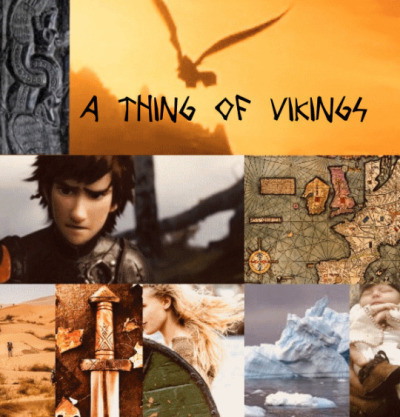
Chapter 14: Relationships
The initial Norwegian outreach to Berk, notwithstanding popular belief otherwise, was actually instigated by Magnus the Good's regent, Einar Eindridesson Thambarskelfir (c. 980-1047), of the Lade jarls, not Magnus the Good, although he was an enthusiastic supporter of the idea.
Originally an opponent of King Olaf Haraldsson, Magnus's father, Einar supported King Cnut the Great's efforts to overthrow Olaf. Those efforts succeeded in 1028 AD, sending King Olaf and his family into exile. Olaf returned two years later after the death of Cnut's first viceroy, Haakon Ericsson, in an attempt to regain his kingdom, and died at the Battle of Stiklestad (29 July 1030 AD), defeated by a peasant army led by Kálfr Árnasson, Thorir Hund and Hárek of Tjøtta. Einar was not present at the battle, but this was more due to happenstance than intent—Einar was visiting King Cnut in London when the battle was joined. The purpose of his visit was to petition Cnut to make him the new viceroy of Norway.
The petition failed; Einar was not given the viceroyalty over Norway, and neither were any of the other Norwegian nobility that had supported Cnut. Instead, Cnut chose his fourteen-year-old son Sveinn as viceroy and Sveinn's mother, Ælfgifu of Northampton, as the boy's regent and therefore the effective ruler of Norway. This decision infuriated Einar and the others who had supported Cnut's overthrow of King Olaf, as each of them had wished to be named as regent over Norway, and Cnut had promised each of them the position (or so they claimed). Sveinn and Ælfgifu's subsequent viceroy reign was seen as oppressive due to new laws and taxes, and was marked by intense resistance on the part of the Norwegian nobility.
In 1035 AD, Einar, acting in concert with Kálfr, betrayed Cnut's viceroys. Traveling to Yaroslav the Wise's court in the Kievan Rus', the two chieftains found Olaf's eleven-year-old illegitimate son, Magnus, who had been left there by his father to be fostered in exile by Yaroslav and his wife Ingegerd. Returning to Scandinavia with Magnus, they allied with King Anund Jacob the Coalburner of Sweden, Magnus's step-uncle, to place Magnus on the Norwegian throne as a puppet ruler to the noble chiefs.
Political machinations quickly followed, and Kálfr was quickly outmaneuvered by Einar. Using Kálfr's direct involvement in the death of King Olaf against him, Einar depicted himself as blameless, and managed to have Kálfr incriminate himself by showing how he killed the boy-king's father with a stab to the neck. Einar became Magnus's new regent and effective ruler of Norway, while Kálfr and Thorir were driven into exile. Magnus, reportedly furious, wished to have them executed, but refrained from doing so on the advice of his godfather, Sigvatr the Skald.
His primary rivals gone, Einar spent the next half decade as the de facto ruler of Norway; even when Magnus reached his majority and assumed some level of legal power, Einar made certain to keep the young monarch dependent on him.
This status quo, however, was broken by one of Einar's miscalculations. Hearing of the tamed dragons and dragon-riders of Berk from a traveling skald in the spring of 1041 AD, he dispatched one of his minor rivals in the court, the herald Yngvarr Arlaksson, to make contact with Berk, reasoning that either his rival would be killed by fearsome Norse dragon-riders or they might potentially make an ally of the same.
This backfired, as Berk—and Hiccup Haddock and his associates in particular—were not what he had expected.
—Corpus Historiae Berkiae, 1396
AO3 Chapter Link [14/154]
~~~
My Original Fiction | Original Fiction Patreon
#a thing of vikings#httyd#how to train your dragon#alternate history#historical fiction#forgot to post a link yesterday#so two today
14 notes
·
View notes
Text
Marlena Caya Hvitserksdóttir
The wild, unpredictable Norse Queen of Scots.
"I may live in Scotland but I have the heart of a Norse."



"You're beautiful and clever and unpredictable. Like your mother, you know how to use your beauty and could have the whole world at your feet. You are aware of it, but you don't use it because other people are more important to you than you are. You are like your mother, a whirlwind but with a heart of gold. There's this fire inside of you that's the same as your mother's. You're a warrior, you know how to fight, but you prefer to use your wits to win wars. That's what makes you who you are, what makes you special." Hvitserk to his daughter.





Marlena Caya Hvitserksdóttir - daughter of Hvitserk and Caya, sister of Illian, granddaughter of the two great men Ragnar and Flóki the boatbuilder, niece of the King and Queen of Kattegat, Ivar the boneless and Xenia Princess of Rus and the cousin of Vidar, Edda and Cailan. Passionate and balanced is what best describes Marlena, but she is also an idiosyncratic woman. She proves to be a formidable enemy for anyone who stands in her way. She is also a great ally as she always puts other people before herself. As a child, Marlena was described as very talkative and free with words, but in her youth she became stronger to stand up for what she believes in. She has grown into an independent woman who will do anything to protect the people she loves and her country. She is a warrior but she is also the romantic, both in equal parts. Many describe her as a truly remarkable woman, very witty, charming, adventurous, wild and full of passion. Taking after her mother, she has an unbridled fire, an unbreakable will and is often unpredictable, but like her mother, she is also an extremely intelligent young woman. She speaks different languages, she rides horses and she is good at hunting. Marlena has a close relationship with her brother, her cousin and her cousins because she grew up with them. Family always comes first for her, which she would not hesitate to defend and protect with her own life at any time. Her father is her great hero, whom she loves more than anything else. Marlena also has a very close relationship with her grandfather, her uncle and her aunt and loves them unconditionally. She is a real whirlwind with the heart of a Norse, strong belief in the gods and the destiny given by them. Because of a planned alliance between Norway and Scotland, she was sent to Scotland together with her brother, her cousin, her cousins and her confidant Marcellus to meet and marry the Scottish king. On the day of her marriage, she was crowned Queen of Scots. Shortly after their marriage, the king died, making her the sole ruler of Scotland. Even though she is a kind queen who loves her people and always does everything she can to protect the people of Scotland, Marlena or her power and influence should not be underestimated.

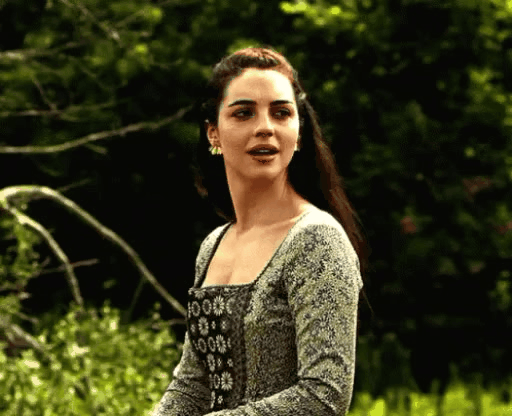
13 notes
·
View notes